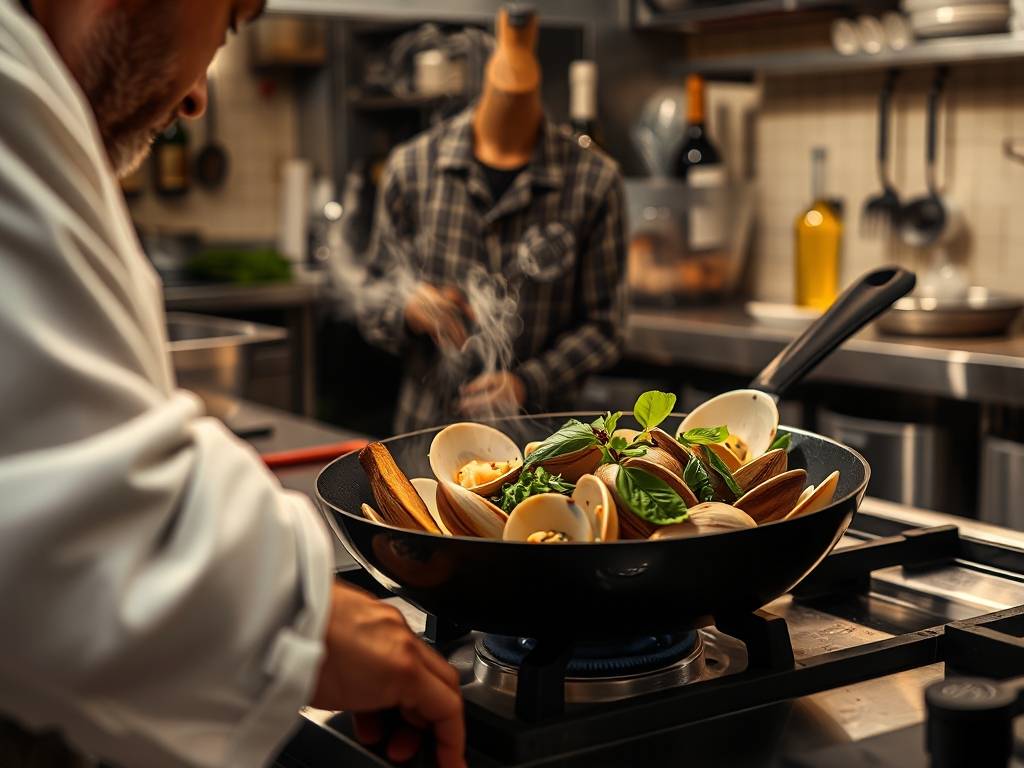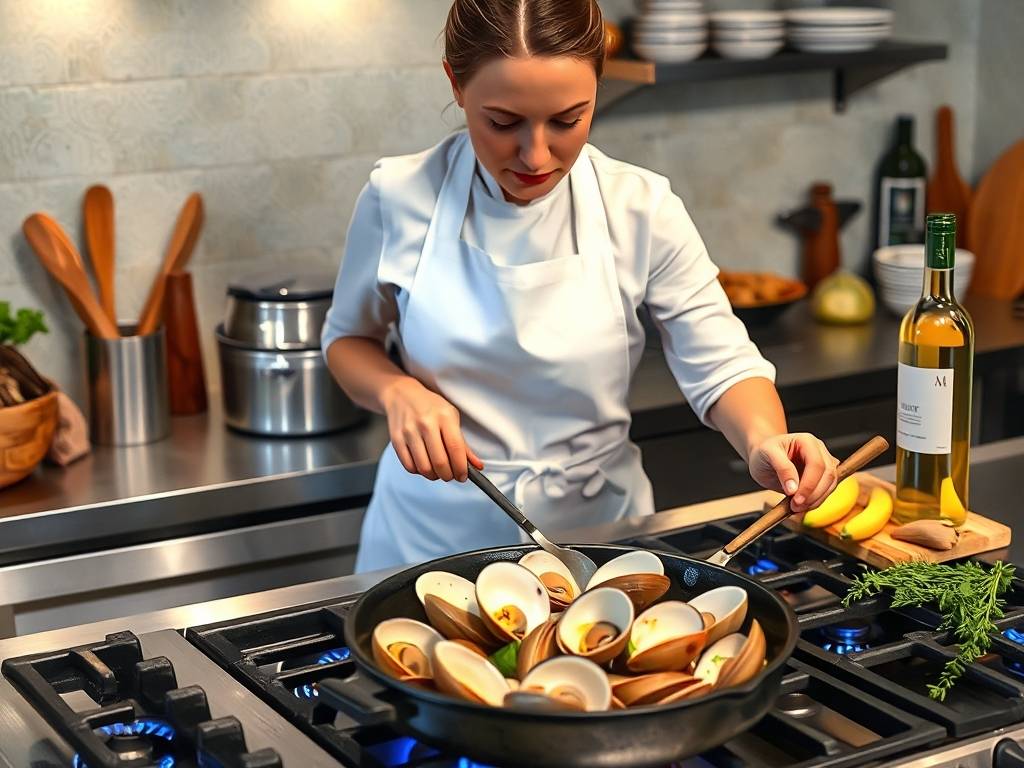The Art of Perfecting Garlic and White Wine Butter Clams
There is something undeniably magical about the combination of fresh clams, garlic, white wine, and butter. This classic dish, found in coastal regions from New England to the Mediterranean, represents the perfect harmony of land and sea. The briny sweetness of clams, the aromatic punch of garlic, the acidity of white wine, and the rich silkiness of butter come together to create a symphony of flavors that dances on the palate. Mastering this dish requires understanding each component and how they interact to create culinary magic.

Selecting Your Clams: The Foundation of Flavor
The journey to perfect garlic and white wine butter clams begins with selecting the right ingredients. For clams, you have several excellent options. Littleneck clams are prized for their tender texture and sweet flavor, while cherrystone clams offer a slightly stronger taste. Manila clams provide a wonderful balance of sweetness and brininess. Whatever variety you choose, ensure they're alive and fresh.
When purchasing clams, look for shells that are tightly closed or close when tapped—this indicates they're alive. Avoid any with cracked shells or that feel unusually heavy (which may indicate sand or mud inside). Plan to cook your clams within 24 hours of purchase, storing them in the refrigerator covered with a damp cloth—never in airtight containers or water, as this will suffocate them.

The Flavor Trinity: Garlic, Wine, and Butter
Garlic forms the aromatic backbone of this dish. While recipes often call for minced garlic, consider using both sliced and minced garlic for layered flavor. The minced garlic will melt into the sauce, while thinner slices will maintain their shape and provide occasional bursts of garlicky goodness. For the most authentic flavor, use fresh garlic rather than pre-minced varieties.
Your choice of white wine significantly impacts the final dish. Select a dry, crisp white wine such as Sauvignon Blanc, Pinot Grigio, or an unoaked Chardonnay. The wine should be something you'd enjoy drinking—never use "cooking wine" from the supermarket, as it often contains added salt and preservatives that can throw off your dish's balance.
Butter adds richness and helps create a luxurious sauce. European-style butter with higher fat content will give you a silkier texture, but regular unsalted butter works perfectly. For an extra layer of flavor, consider combining butter with a small amount of olive oil, which will help prevent the butter from burning while adding its own distinct character.
The Preparation Process: A Step-by-Step Guide
Begin by thoroughly cleaning your clams. Place them in a large bowl of cold water with a handful of salt (approximately 1/4 cup per gallon of water) and let them soak for 20-30 minutes. This encourages them to expel any sand or grit. Some cooks add cornmeal to the water, believing it helps purge the clams more effectively. After soaking, scrub the shells with a stiff brush under running water to remove any remaining debris.
While the clams are purging, prepare your aromatics. Mince or slice your garlic—about 4-6 cloves for 2 pounds of clams. Chop a small handful of fresh parsley and have it ready for finishing. If you enjoy a subtle heat, have a pinch of red pepper flakes standing by.
In a large, heavy-bottomed pot or Dutch oven with a tight-fitting lid, melt 2 tablespoons of butter with 1 tablespoon of olive oil over medium heat. Add the garlic and cook until fragrant—about 1 minute—being careful not to let it brown. Add 1 cup of white wine and bring to a simmer, allowing it to reduce slightly for 2-3 minutes.
Add the cleaned clams to the pot, cover, and increase the heat to medium-high. Steam the clams for 5-10 minutes, shaking the pot occasionally, until they open. Discard any clams that remain closed after cooking.
Remove the clams with a slotted spoon and place them in serving bowls. Return the pot to the heat and add another 2 tablespoons of butter, swirling until melted and incorporated into the cooking liquid. Stir in the chopped parsley and a squeeze of fresh lemon juice. Taste and adjust seasoning with salt and pepper if needed.
Pour the sauce over the clams and serve immediately with crusty bread for soaking up the delicious broth.
Advanced Techniques and Variations
Once you've mastered the basic recipe, consider these variations to make the dish your own:
Herb-Infused Butter: Create a compound butter by mixing softened butter with chopped herbs like parsley, chives, and tarragon. Add a dollop to the finished dish for an extra burst of flavor.
Wine Alternatives: While white wine is traditional, some cooks enjoy using dry vermouth or even a light beer for a different flavor profile.
Creamy Version: For a richer sauce, add a splash of heavy cream after removing the clams and reduce slightly before adding the final butter.
Spicy Twist: Sauté sliced chorizo or red pepper flakes with the garlic for a spicy variation.
Tomato Addition: Add a handful of cherry tomatoes or a tablespoon of tomato paste with the wine for a slightly different flavor dimension.
Pairing and Serving Suggestions
Garlic and white wine butter clams make a spectacular appetizer or light main course. For a complete meal, serve them over linguine or with roasted potatoes. The classic accompaniment is crusty bread—a rustic baguette or sourdough is perfect for sopping up the delicious sauce.
When it comes to wine pairing, you have two excellent options: either serve the same wine you used in cooking, or select a complementary variety. A crisp, high-acid white wine like Muscadet or Vermentino cuts through the richness beautifully. For beer lovers, a Belgian-style witbier or a light pilsner makes an excellent pairing.
Troubleshooting Common Issues
Even experienced cooks can encounter challenges with this seemingly simple dish. Here are solutions to common problems:
Sandy Clams: If your clams are gritty, you may not have purged them sufficiently. Next time, extend the soaking time or try the cornmeal method. If you're serving guests and discover sand, you can carefully strain the sauce through cheesecloth before serving.
Tough Clams: Overcooking makes clams rubbery. Remove them from the heat as soon as they open.
Broken Sauce: If your sauce separates, whisk in a teaspoon of cold butter off the heat to bring it back together.
Too Salty: Clams release their natural brine, which can make the sauce overly salty. If this happens, add a squeeze of lemon juice or a splash of water to balance the flavors.
The Cultural Journey of a Classic Dish
While this dish feels inherently Mediterranean, variations appear in coastal cuisines worldwide. In Italy, it's known as "vongole," often prepared with spaghetti. In Portugal, "ameijoas à Bulhão Pato" features a similar preparation with cilantro instead of parsley. New England clam bakes incorporate beer-steamed clams with drawn butter. Each culture has put its own spin on the basic concept, proving the universal appeal of this simple yet sublime combination.
The beauty of garlic and white wine butter clams lies in their simplicity—few ingredients, minimal cooking time, yet maximum flavor impact. This dish demonstrates how quality ingredients treated with respect can create something greater than the sum of its parts. Whether you're cooking for a special occasion or a simple weeknight dinner, mastering this recipe will give you a go-to dish that never fails to impress.
Remember that cooking is both art and science—follow the basic principles but don't be afraid to adapt the recipe to your taste preferences. The best dishes are those made with attention and care, and this classic preparation rewards every moment you invest in it. So head to your fish market, select the freshest clams you can find, and embark on your own culinary journey to garlic and white wine butter clam perfection.






发表评论